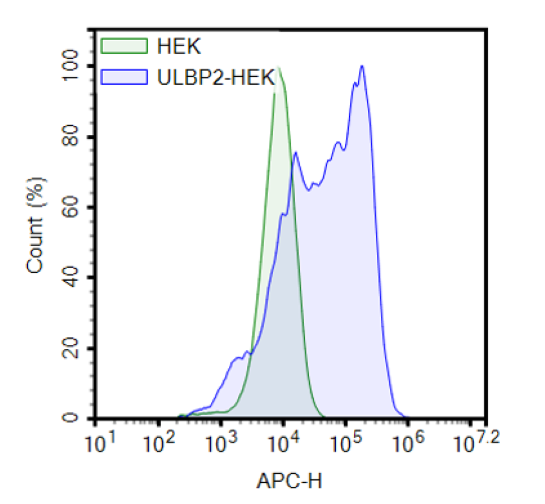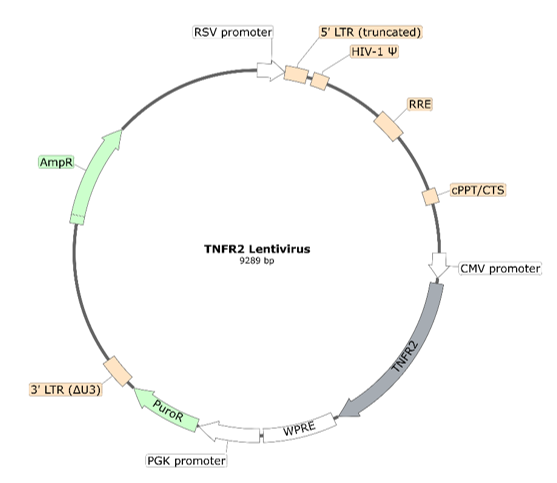78744
ULBP2 Lentivirus
BPS Bioscience
DESCRIPTION
The ULBP2 (UL16 binding protein 2) Lentiviruses are replication incompetent, HIV-based, VSV-G pseudotyped lentiviral particles ready to transduce most types of mammalian cells, including primary and non-dividing cells. These viruses transduce cells with human ULBP2 (NM_025217.4) driven by an EF1a promoter. The lentiviruses also transduce a puromycin selection gene.
DETAILS
- Notes: To generate ULBP2-expressing stable cells, remove the growth medium 48 hours after transduction and replace it with fresh growth medium containing the appropriate amount of puromycin (as pre-determined from a killing curve), for selection of the transduced cells. Visit: bpsbioscience.com/cell-line-faq for guidelines on how to perform a kill curve. Biosafety: The lentiviruses are produced with a SIN (self-inactivation) lentivector which ensures self-inactivation of the lentiviral construct after transduction and after integration into the genomic DNA of the target cells. None of the HIV genes (gag, pol, rev) will be expressed in the transduced cells, as they are expressed from packaging plasmids lacking the packing signal and are not present in the lentivirus particle. Although the pseudotyped lentiviruses are replication-incompetent, they require the use of a Biosafety Level 2 facility. BPS Bioscience recommends following all local federal, state, and institutional regulations and using all appropriate safety precautions. Troubleshooting Guide: Visit bpsbioscience.com/lentivirus-faq for detailed troubleshooting instructions. For further questions, email support@bpsbioscience.com.
- Shiptemp: -80°C (dry ice)
- Synonyms: UL16 Binding Protein 2, Retinoic Acid Early Transcript 1H, NKG2D Ligand 2, and ALCAN-Alpha
- Warnings: Avoid freeze/thaw cycles
- Category: Immunotherapy/Lentivirus
- Background: ULBP2 (UL16 binding protein 2) is a glycoprotein related to MHC class I molecules that belongs to the family of unique length 16 (UL16) binding proteins. It is a stress-induced ligand for the activating NKG2D receptor in NK (natural killer) cells. It contains the MHC class-I-like α1-α2 domains but lacks the α3 region present in MICA/B proteins and uses GPI (glycosylphosphatidylinositol) as anchor to the plasma membrane. Stress ligands respond to viral infections, heat shock, or other cellular stresses, and are also crucial in immune surveillance. ULBP2 is expressed at low levels in normal tissues but overexpressed in several types of cancer (such as liver, breast, cervical and skin), with its levels correlated to the severity of the prognosis. Targeting ULBP2, for example with miR-6071, reduced tumorigenicity in glioblastoma. Targeting ULBP2 may prove beneficial in combination with NK-based cancer therapy.
- Description: The ULBP2 (UL16 binding protein 2) Lentiviruses are replication incompetent, HIV-based, VSV-G pseudotyped lentiviral particles ready to transduce most types of mammalian cells, including primary and non-dividing cells. These viruses transduce cells with human ULBP2 (NM_025217.4) driven by an EF1a promoter. The lentiviruses also transduce a puromycin selection gene.
- Formulation: The lentiviruses were produced in HEK293T cells in medium containing 90% DMEM + 10% FBS. Virus particles can be packaged in custom formulations by special request, for an additional fee.
- Supplied As: Two vials (500 µl x 2) of lentivirus at a titer≥107 TU/ml. The titer will vary with each lot; the exact value is provided with each shipment.
- Unspsc Code: 41106621
- Unspsc Name: Virus mediated expression vectors or kits
- Applications: • Expression of human ULBP2 in cells of interest. • Generate stable cell lines expressing human ULBP2 (puromycin resistant).
- Product Type: Lentivirus
- Biosafety Level: BSL-2
- Related Products: 100544, 78716, 78714, 78715
- Storage Stability: Lentiviruses are shipped with dry ice. For long-term storage, it is recommended to store the lentiviruses at -80°C.
- Scientific Category: Immunotherapy

